Malcolm Barnes. Practical Variable Speed Drives and Power Electronics
Подождите немного. Документ загружается.


Power electronic converters 99
modulation frequency depends on the type of switching device and its frequency. With
the force-commutated thyristor inverter (10 years ago), a modulation frequency of up to
1 kHz was possible. With the introduction of GTOs and BJTs, this could be pushed up to
around 5 kHz. With IGBTs, the modulation frequency could be as high as 20 kHz. In
practice, a maximum modulation frequency of up to 12 kHz is common with IGBT
inverters up to about the 22 kW motor size and 8 kHz for motors up to about 500 kW.
The choice of modulation frequency is a trade off between the losses in the motor and in
the inverter. At low modulation frequencies, the losses in the inverter are low and those in
the motor are high. At high modulation frequencies, the losses in the inverter increase,
while those in the motor decrease.
One of the most common techniques for achieving sine-coded PWM in practical
inverters is the sine-triangle intersection method shown in Figure 3.30.
A triangular saw-tooth waveform is produced in the control circuit at the desired
inverter switching frequency. This is compared in a comparator with a sinusoidal
reference signal, which is equal in frequency and proportional in magnitude to that of the
desired sinusoidal output voltage. The voltage V
AN
(Figure 3.30(b)) is switched high
whenever the reference waveform is greater than the triangle waveform. The voltage V
BN
(Figure 3.30(c)) is controlled by the same triangle waveform but with a reference
waveform shifted by 180˚.
The actual phase-to-phase output voltage is then V
AB
(Figure 3.30(d)), which is the
difference between V
AN
and V
BN
, which consists of a series of pulses each of whose width
is related to the value of the reference sine-wave at that time. The number of pulses in the
output voltage V
AB
is double that in the inverter leg voltage V
AN
. For example, an inverter
switching at 5 kHz should produce switching distortion at 10 kHz in the output phase-to-
phase voltage. The polarity of the voltage is alternatively positive and negative at the
desired output frequency.
Figure 3.30:
Principle of triangle intersection PWM
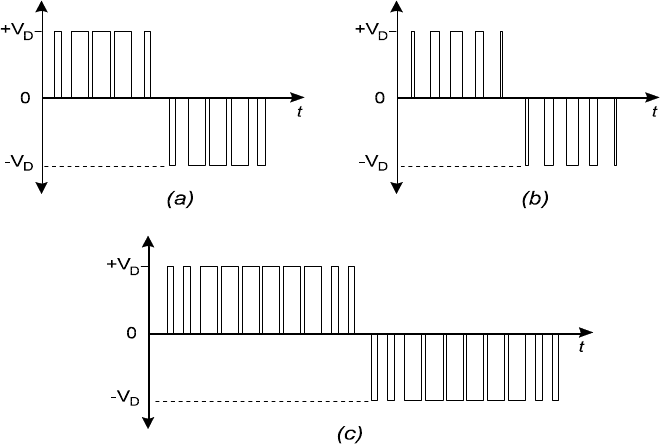
100 Practical Variable Speed Drives and Power Electronics
It can also be seen that the reference sine-wave in Figure 3.30 is given a DC component
so that the pulse produced by this technique has a positive width. This puts a DC bias on
the voltage of each leg as shown in Figures 3.30 (b) & (c). However, each leg has the
same DC offset which disappears from the load voltage.
The technique using sine-triangle intersection is particularly suited for use with the
older analogue control circuits, where the two reference waveforms were fed into a
comparator and the output of the comparator was used to trigger the inverter switches.
Modern digital techniques operate on the basis of a switching algorithm, for example
by producing triggering pulses proportional to the area under a part of the sine wave. In
recent times, manufacturers have developed a number of different algorithms that
optimize the performance of the output waveforms for AC induction motors. These
techniques result in PWM output waveforms which are similar to those shown in
Figure 3.30.
The sine-coded PWM voltage waveform is a composite of a high frequency square
wave at the pulse frequency (the switching carrier) and the sinusoidal variation of its
width (the modulating waveform). It has been found that, for lowest harmonic distortion,
the modulating waveform should be synchronised with the carrier frequency, so that is it
should contain an integral number of carrier periods. This requirement becomes less
important with high carrier frequencies of more than about twenty times the modulating
frequency.
The voltage and frequency of a sinusoidal PWM waveform are varied by changing the
reference waveform of Figure 3.30(a) giving outputs as shown in Figure 3.31.
• Figure 3.31(a) shows a base case, with the rated V/f ratio
• Figure 3.31(b) shows the case where the voltage reference is halved, resulting
in the halving of each pulse
• Figure 3.31(c) shows the case where the reference frequency is halved,
resulting in the extension of the modulation over twice as many pulses
Figure 3.31:
Variation of frequency and voltage with sinusoidal PWM
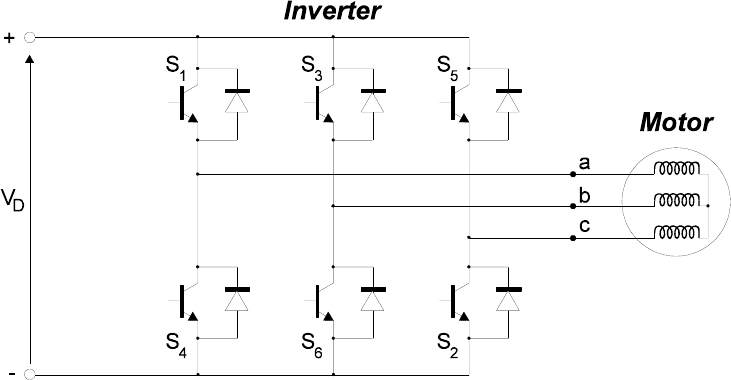
Power electronic converters 101
The largest voltage with sine-coded PWM occurs when the pulses in the middle are
widest, giving an output with a peak voltage equal to the supply. The modulation index is
defined as the ratio of the peak AC output to the DC supply. Thus the largest output
voltage occurs when the modulation index is 1. It is possible to achieve larger voltages
than the DC supply by abandoning strict sine-PWM by adding some distortion to the
sinusoidal reference voltage. This results in the removal of some of the pulses near the
centre of the positive and negative parts of the waveform, a process called pulse
dropping. In the limit, a square wave voltage waveform can be achieved with a peak
value which is up to 127% of what can be achieved by strict sine-PWM.
3.7.3 Three-phase inverter
A three-phase inverter could be constructed from three inverters of the type shown in
Figure 3.24. However, it is more economical to use a 6-pulse (three-leg) bridge inverter
as shown in Figure 3.32.
Figure 3.32:
Three-phase inverter using gate controlled switches
In its simplest form, a square output voltage waveform can be obtained by switching
each leg high for one half-period and low for the next half-period, at the same time
ensuring that each phase is shifted one third of a period (120
o
) as shown in the Figure
3.33. The resulting phase-to-phase voltage waveform comprises a series of square pulses
whose widths are two thirds of the period of the switch in each phase. The resulting
voltage waveform is called a quasi-square wave (QSW) voltage. This simple technique
was used in early voltage source inverters (VSI) which used forced commutated thyristors
in the inverter bridge. To maintain a constant V/f ratio, the magnitude of the DC bus
voltage was controlled by the rectifier bridge to keep a fixed ratio to the output frequency,
which was controlled by the inverter bridge. This technique was sometimes also called
pulse amplitude modulation (PAM).
The output voltage of a three-phase converter has a harmonic spectrum very similar to
the single-phase square wave, except that the triplen harmonics (harmonics whose
frequency is a multiple of three times the fundamental frequency) have been eliminated.
In an inverter with a 3-phase output, this means that the 3rd, 9th, 15th, 21st, etc
harmonics are eliminated. To develop a 3-phase variable voltage AC output of a
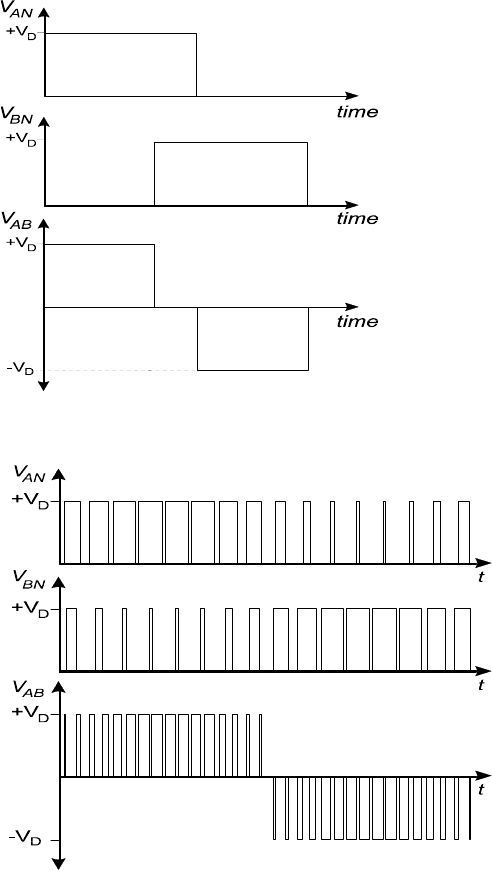
102 Practical Variable Speed Drives and Power Electronics
particular frequency, the voltages V
AN
, V
BN
, V
CN
on the 3 output terminals a, b, & c in
Figure 3.32 can be modulated on and off to control both the voltage and the frequency.
The pulse-width ratio over the period can be changed according to a sine-coded PWM
algorithm.
When the phase-phase voltage V
AB
is formed, the present modulation strategy gives
only positive pulses for a half period followed by negative pulses for a half period, a
condition known as consistent pulse polarity. It can be shown that consistent pulse
polarity guarantees lowest harmonic distortion with most of the distortion being at twice
the inverter chopping frequency. The presence of both positive and negative pulses
throughout the whole period of the phase–phase voltage (inconsistent pulse polarity)
gives distortion at the inverter chopping frequency, where it will have more effect on
current distortion and is a sign of a poor modulation scheme.
Figure 3.33:
Quasi square wave modulation output waveforms
Figure 3.34:
Output voltage waveform of a 3-phase sine coded PWM

Power electronic converters 103
Manufacturers of AC frequency converters continue to work on the development of
more efficient PWM algorithms in an attempt to improve the current waveform. The
ultimate objective is a completely sinusoidal current, which produces no harmonic losses
in the motor. These more advanced PWM algorithms have become possible as a result of
the increased speed and power of microprocessors. Most reputable PWM inverters can
operate at modulation frequencies between 2 kHz and 16 kHz and produce a current
waveform, which is sufficiently sinusoidal to overcome the problem of motor de-rating
for harmonic losses. However, as a result of the high PWM frequencies, a new problem
has emerged, the high frequency leakage current due to the motor cable capacitance. This
issue is covered in Chapter 4.
In practical inverters, there are two conflicting requirements which need to be met when
it is required to accelerate a motor from standstill to rated speed with constant V/f ratio.
• The need to operate the inverter at its highest possible switching frequency to
achieve low current distortion
• The importance of maintaining synchronization
A common strategy to achieve both, particularly for older PWM inverters, is to begin
with the inverter switching frequency at about half the maximum value. As the speed is
increased, the saw-tooth carrier frequency is increased in proportion to maintain
synchronism. When the carrier frequency reaches its maximum, it is then switched to half
its value for further increase in the output frequency.
Thus the inverter exhibits a continual ramp increase in frequency followed by a sudden
reduction at the changeover point. If the inverter is operating in the audible range then a
change in pitch will be heard similar to the sound of a car engine as the car accelerates
through the gears, hence the term ‘gear-changing’.
Figure 3.35:
Changing the modulation frequency in steps (gear-changing)
When the motor speed is reduced from maximum to zero, there is a similar change in
carrier frequency with output frequency. However, the changeover points must be
different, otherwise an inverter sitting at one of the changeover frequencies might
continually oscillate between the upper and lower carrier frequency. This is avoided by
introducing hysteresis in the control scheme as shown in Figure 3.35.

104 Practical Variable Speed Drives and Power Electronics
3.8 Gate controlled power electronic devices
A number of gate controlled devices have become available in the past decade, which are
suitable for use as bi-stable switches on power inverters for AC Variable Speed Drives.
These can be divided into two main groups of components:
• Those based on thyristor technology such as gate turnoff thyristor (GTO) and
field controlled thyristor (FCT)
• Those based on transistor technology such as the bipolar junction transistor
(BJT), field effect transistor (FET) and the insulated gate bipolar transistor
(IGBT)
3.8.1 Gate turn-off thyristor (GTO)
A GTO thyristor is another member of the thyristor family and is very similar in
appearance and performance to a normal thyristor, with the important additional feature
that it can be turned off by applying a negative current pulse to the gate. GTO thyristors
have high current and voltage capability and are commonly used for larger converters,
especially when self commutation is required.
SYMBOL:
IDEAL: Forward conduction: Resistance (less)
Forward blocking: Loss (less) (no leakage current)
Reverse blocking: Loss (less) (no leakage current)
Switch on/off time: Instantaneous
The performance of a GTO is similar to a normal thyristor. Forward conduction is
blocked until a positive pulse is applied to the gate terminal. When the GTO has been
turned on, it behaves like a thyristor and continues to conduct even after the gate pulse is
removed, provided that the current is higher than the holding current. The GTO has a
higher forward voltage drop of typically 3 V to 5 V. Latching and holding currents are
also slightly higher.
The important difference is that the GTO may be turned off by a negative current pulse
applied to the gate terminal. This important feature permits the GTO to be used in self
commutated inverter circuits. The magnitude of the off pulse is large and depends on the
magnitude of the current in the power circuit. Typically, the gate current must be 20% of
the anode current. Consequently, the triggering circuit must be quite large and this results
in additional commutation losses. Like a thyristor, conduction is blocked in the reverse
biased direction or if the holding current falls below a certain level.
Since the GTO is a special type of thyristor, most of the other characteristics of a
thyristor covered above also apply to the GTO and will not be repeated here. The
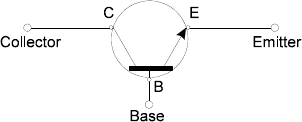
Power electronic converters 105
mechanical construction of a GTO is very similar to a normal thyristor with stud types
common for smaller units and disc types common for larger units.
GTO thyristors are usually used for high voltage and current applications and are more
robust and tolerant to over-current and over-voltages than power transistors. GTOs are
available for ratings up to 2500 amps and 4500 volts. The main disadvantages are the
high gate current required to turn the GTO off and the high forward volt drop.
Power electronic converters of all types are usually controlled by an electronic control
circuit which controls the on/off state of the power electronic devices and provides the
interface for the external controls. Until recently, all control circuits were of the analog
type using operational amplifiers (Op-Amps). Modern control circuits are usually of the
digital type using microprocessors.
3.8.2 Field controlled thyristors (FCT)
Although the GTO is likely to maintain its dominance for the high power, self
commutated converter applications for some time, new types of thyristor are under
development in which the gate is voltage controlled. Turn on is controlled by applying a
positive voltage signal to the gate and turn off by a negative voltage. Such a device is
called a field controlled thyristor (FCT) and the name highlights the similarity to the field
effect transistor (FET). The FCT is expected to eventually supersede the GTO because it
has a much simpler control circuit in which both the cost and the losses may be
substantially reduced. Small FCTs have become available and it is expected that larger
devices will come into use in the next few years. Development of a practical cost
effective device has been a bit slower than expected.
3.8.3 Power bipolar junction transistors (BJT)
Transistors have traditionally been used as amplification devices, where control of the
base current is used to make the transistor conductive to a greater or lesser degree. Until
recently, they were not widely used for power electronic applications. The main reasons
were that the control and protective circuits were considerably more complicated and ex-
pensive and transistors were not available for high power applications. They also lacked
the overload capacity of a thyristor and it is not feasible to protect transistors with fuses.
In the mid-1980s, the NPN transistor known as a bipolar junction transistor (BJT) has
become a cost effective device for use in power electronic converters. Modern BJTs are
usually supplied in an encapsulated module and each BJT has two power terminals,
called the collector (C) and emitter (E), and a third control terminal called the base (B).
SYMBOL:
IDEAL: Forward conduction: Resistance (less)
Forward blocking: Loss (less) (no leakage current)
Reverse blocking: Loss (less) (no leakage current)
Switch on/off time: Instantaneous
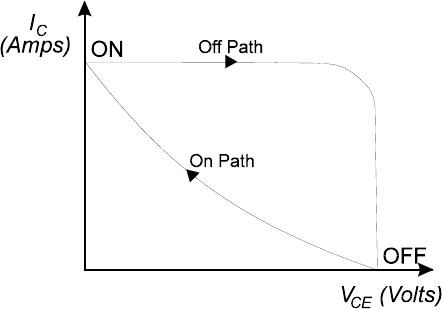
106 Practical Variable Speed Drives and Power Electronics
A transistor is not inherently a bi-stable (on/off) device. To make a transistor suitable
for the conditions in a power electronic circuit where it is required to switch from the
blocking state (high voltage, low current) to the conducting state (low voltage, high
current) it must be used in its extreme conditions, fully off to fully on. This potentially
stresses the transistor and the trigger and protective circuits must be co-ordinated to
ensure the transistor is not permitted to operate outside its safe operating area.
Suitable control and protective circuits have been developed to protect the transistor
against over-current when it is turned on and against over-voltage when it is turned off.
When turned on, the control circuit must ensure that the transistor does not come out of
saturation otherwise it will be required to dissipate high power. In practice, the control
system has proved to be cost effective, efficient, and reliable in service.
Figure 3.36:
Switching locus of a power BJT with an inductive load
Transistors do not tolerate reverse voltages. When BJTs are used in inverter bridges,
they must be protected against high reverse voltages by means of a reverse diode in series
or in parallel. For the same reason, transistors are not used in rectifier bridges, which have
to be able to withstand reverse voltages.
In general, transistors were considered to be less robust and less tolerant of overloads
and ‘spikes’ than thyristors. GTO thyristors were often preferred for converters. In spite
of the earlier problems experienced with transistors, AC converters have used power
transistors at power ratings up to about 150 kW at 415 V.
The main advantage of transistors is that they can be turned on and off from the base
terminal, which makes them suitable for self commutated inverter circuits. This results in
power and control circuits which are simpler than those required for thyristors.
Unfortunately, the base amplification factor of a transistor is fairly low (usually 5 to 10
times) so the trigger circuit of the transistor must be driven by an auxiliary transistor to
reduce the magnitude of the base trigger current required from the control circuit. The
emitter current from the auxiliary transistor drives the base of the main transistor using
the Darlington connection. Figure 3.37 shows a double Darlington connection, but for
high power applications, two auxiliary transistors (triple Darlington) may be used in
cascade to achieve the required amplification factor. The overall amplification factor is
approximately the product of the amplification factors of the two (or three) transistors.
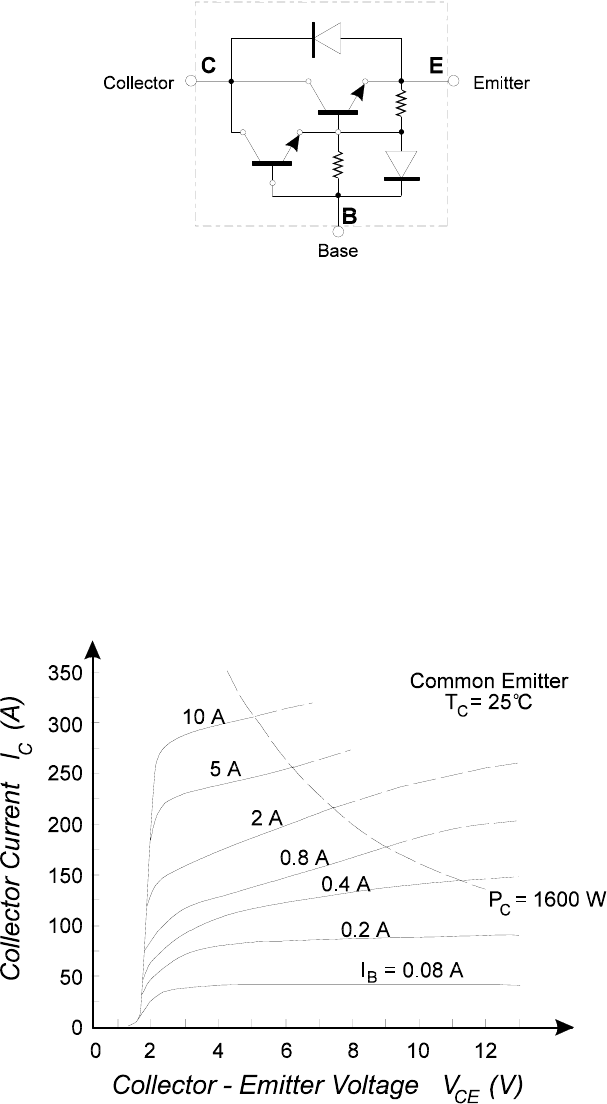
Power electronic converters 107
Figure 3.37:
Power Darlington transistor
Transistors, used in VSD applications, are usually manufactured as an integrated circuit
and encapsulated into a 3 terminal module, complete with the other necessary
components, such as the resistors and anti-parallel protection diode. The module has an
insulated base suitable for direct mounting onto the heat-sink. This type of module is
sometimes called a power Darlington transistor module.
As shown in Figure 3.37, the anti-parallel diode protects the transistors from reverse
biasing. In practice, this diode in the integrated construction is slow and may not be fast
enough for inverter applications. Consequently, converter manufacturers sometimes use
an external fast diode to protect the transistors.
The following figure shows the saturation characteristic of Toshiba MG160 S1UK1
triple Darlington power transistor rated at 1400 V, 160 amp with a built-in free-wheeling
diode.
Figure 3.38:
Characteristics of a 160 amp bipolar junction transistor (BJT)
Although the control circuits are completely different, the power circuit performance of
a BJT is similar to a GTO thyristor. Forward conduction is blocked until a positive
current is applied to the gate terminal and will conduct as long as the voltage is applied.
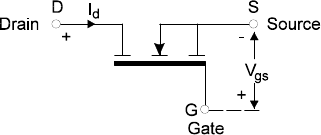
108 Practical Variable Speed Drives and Power Electronics
During forward conduction, it also exhibits a forward voltage drop which causes losses in
the power circuit. The BJT may be turned off by applying a negative current to the gate.
The main advantages of the bipolar junction transistor (BJT) are:
• Good power handling capabilities
• Low forward conduction voltage drop
The main disadvantages of BJTs are:
• Relatively slow switching times
• Inferior safe operating area
• Has complex current controlled gate driver requirements
Power bipolar junction transistors are available for ratings up to a maximum of about
300 amps and 1400 volts. For VSDs requiring a higher power rating, GTOs are usually
used in the inverter circuit.
3.8.4 Field effect transistor (FET)
A field effect transistor (FET) is a special type of transistor that is particularly suitable for
high speed switching applications. Its main advantage is that its gate is voltage
controlled rather than current controlled. It behaves like a voltage controlled resistance
with the capacity for high frequency performance.
FETs are available in a special construction known as the MOSFET. MOS stands for
metal oxide silicon. The MOSFET is a three terminal device with terminals called the
source (S), drain (D), and the gate (G), corresponding to the emitter, collector, and gate
of the NPN transistor.
SYMBOL:
IDEAL: Forward conduction: Resistance (less)
Forward blocking: Loss (less) (no leakage current)
Reverse blocking: Loss (less) (no leakage current)
Switch on/off time: Instantaneous
The overall performance of an FET is similar to a power transistor, except that the gate
is voltage controlled. Forward conduction is blocked if the gate voltage is low, typically
less than 2 volts. When a positive voltage V
gs
is applied to the gate terminal, the FET
conducts and the current will quickly rise in the FET to a level dependent on the gate
voltage. The FET will conduct as long as gate voltage is applied. The FET may be turned
off by removing the voltage applied to the gate terminal or making it negative.
MOSFETs are majority carrier devices, so they do not suffer from long switching times.
With their very short switching times, the switching losses are low. Consequently, they
